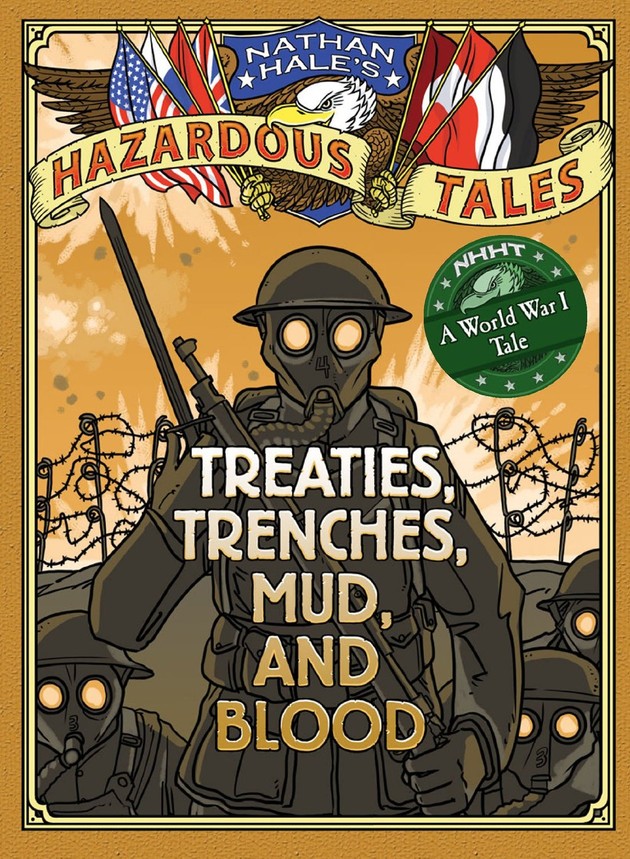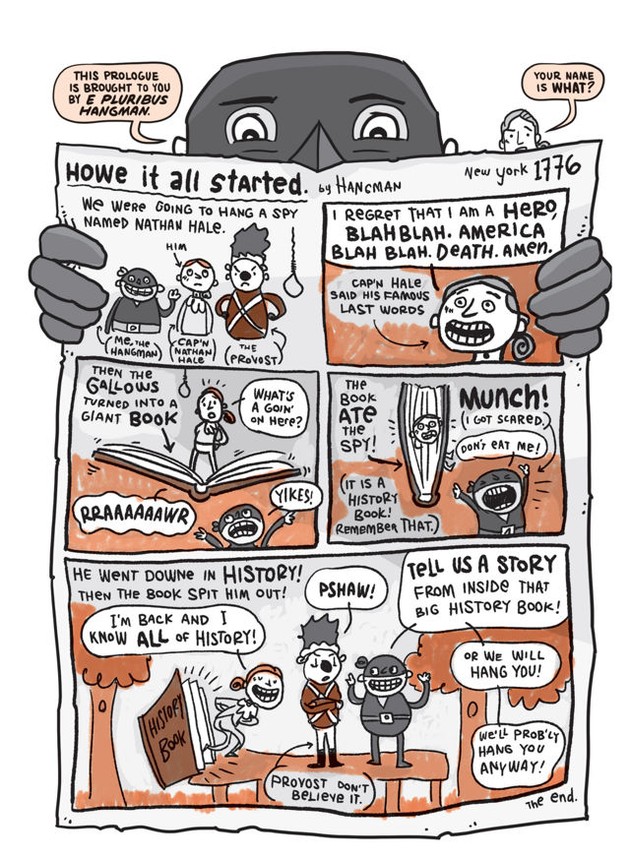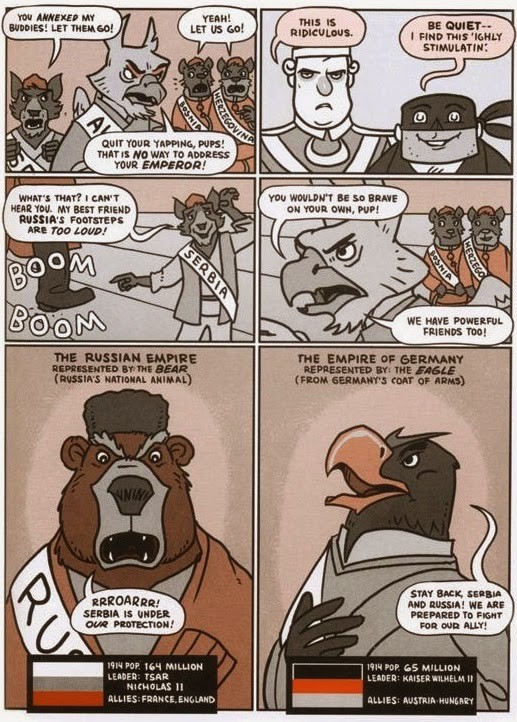Nathan Hale’s Hazardous Tales: Treaties, Trenches, Mud, and Blood (9 out of 10) Nathan Hale, Amulet Books, 2014
There are times as a teacher and parent that I’ll come across a book that hits all the right notes for middle grades. A combination of excitement and humor, adventure and horror, with an overall message that’s important enough for me to recommend to every kid, and parent, and teacher I meet. When I’m really really lucky, that book will be part of a series. That’s what’s happened with “Nathan Hale’s Hazardous Tales.”

The series of history-themed graphic novels kicked off in 2012 with “One Dead Spy,” the Revolutionary War story of Nathan Hale. He’s the patriot spy who…well, he got caught and executed on his first mission. In the book series (by author Nathan Hale, funnily enough), that execution creates this magic moment where Hale, his hangman, and the provost overseeing the hanging all become observers of American History. Nathan Hale is an omniscient narrator, with the other two taking the roles of comedy relief (Hangman) and plot exposition-prodder (Provost). After “One Dead Spy,” we also had the Civil War’s “Big Bad Ironclad,” and Westward Expansion’s “Donner Dinner Party.” Yeah, he went there.
The fourth book in the series is the World War I tale “Treaties, Trenches, Mud, and Blood.” I have a big ol’ history teacher crush on World War I, and with this being the centenary year of the beginning of that conflict, I’m loving all of the hoopla surrounding it. The other three Nathan Hale graphic novels have all focused in on a relatively narrow event–the development of American ironclad ships, for example. This is Hale’s first that’s tried to tackle an entire war, and had it make sense, but still tell compelling stories. Overall, Hale succeeds well, but admits within the book there are other stories to be told that just won’t fit into a 128-page graphic novel.

The reason for the story within the story is that the Very British Provost wants to hear about a story where the United States and Great Britain are allies–so Nathan Hale tells them about World War I. The Hangman being the animal-lover he is, asks that each of the countries be represented by a different kind of “cute little animal.” So Austria-Hungary becomes a Griffin, Serbia a Wolf, Russia a Bear, Germany an Eagle; the allies are a French Gallic Rooster, Belgium is a Lion, UK a Bulldog, and the United States…was going to be a Bald Eagle, but was changed at the last second by the Hangman into a Bunny. Other countries will enter later, but these are the major players. What might seem disrespectful to some actually makes the complicated war easier to follow, and provides some comic relief here and there. At times, for key people, Hale switches to a more realistic human portrait for a quote or dramatic moment, but most of the story is told with cute little animals.

Hale (the author, not the spy)(well, kind of both) does an excellent job of mapping out the treaties and alliances that escalated a regional conflict into a world war; the passionate and misguided nationalism that inspired citizens to rush into their military; and the romantic ideals of war for a generation that was about to lose that idealism in the worst imaginable way.
Some major themes are the shift in tactics and technology that resulted in the deaths of millions; the idea that each country is filled with people who think of themselves as the “good guys,” and the escalation of a war that spun out of control within the first year of combat. For each year of the war, there’s a two-page spread that shows a symbolic God of War–Ares, collecting the dead as they fall. In 1914, he’s an oversized Greek warrior, holding a flaming cauldron, catching the bodies as they fall off of a ramp. That image alone could be used to teach the causes of World War I, as the ramp is held up by the pillars of imperialism, alliances, nationalism, and militarism. The assassination of Archduke Franz Ferdinand is the gate to that ramp, but not the cause of the war becoming World War I. In 1915, Ares is more grotesque, the cauldron larger, and he’s got bandoliers of bullets and shells. The 1916 Ares is a true monster, with smoke pouring from his mouth and ringed with ammunition. 1917 and 1918 make him bigger, uglier, and more mechanized, becoming a kind of cyborg of early 20th Century technology. And truly frightening.
Ares becomes bigger, uglier, and more mechanized.
We get close looks at some key battles that become emblematic of the entire war–Liege, Cer, Ypres, Verdun. Hale is very good at helping kids (and adults) visualize the trench system that became the war’s western front, and illustrating things like the supply lines that were life or death for the soldiers at the front lines. He points out the mismatched technologies that had Germans with machine guns slaughtering Russians with rifles. He gets around to the communist revolution that pulled Russia out of the war early, and the reasons the war accelerated the fall of that empire. We get insight into major leaders on every side, and the push-and-pull between Woodrow Wilson, ex-president Teddy Roosevelt and others that kept the United States out of the war until 1917. We get the Lusitania, the Zimmerman Telegram, and the advent of poison gas, flamethrowers, and tanks. So when Hale (the spy) somewhat apologetically explains that the book isn’t long enough to get to the Air War, with the Red Baron etc., it’s quite alright. We’ve already had an embarrassment of riches. Hale also makes clear that despite the way the tale has been told, with cute little animals, the cost of war is very human and very real.

I could go on forever about this series of books. I have. I do. This one in particular seems to have been a kind of experiment–would it be possible to fit an entire war into a slim graphic novel and still do it justice? In my opinion, the answer is yes. Are there things missing? Sure. But thousand-page treatments of World War I miss things too. For kids in say, 4th-8th grades, this book is an amazing way to learn about The War to End All Wars, and do it in a way they’ll actually want to read. My 12 year-old devoured it, and even my 10 year-old, an adamant reluctant reader is working his way through the other books in the series.
If you haven’t heard of “Nathan Hale’s Hazardous Tales,” it’s time you did. They’re some of the best history books I’ve read. You’ll like them, your kids will love them. Number 5 is due April 21, 2015 – the story of Harriet Tubman. I can’t wait.
